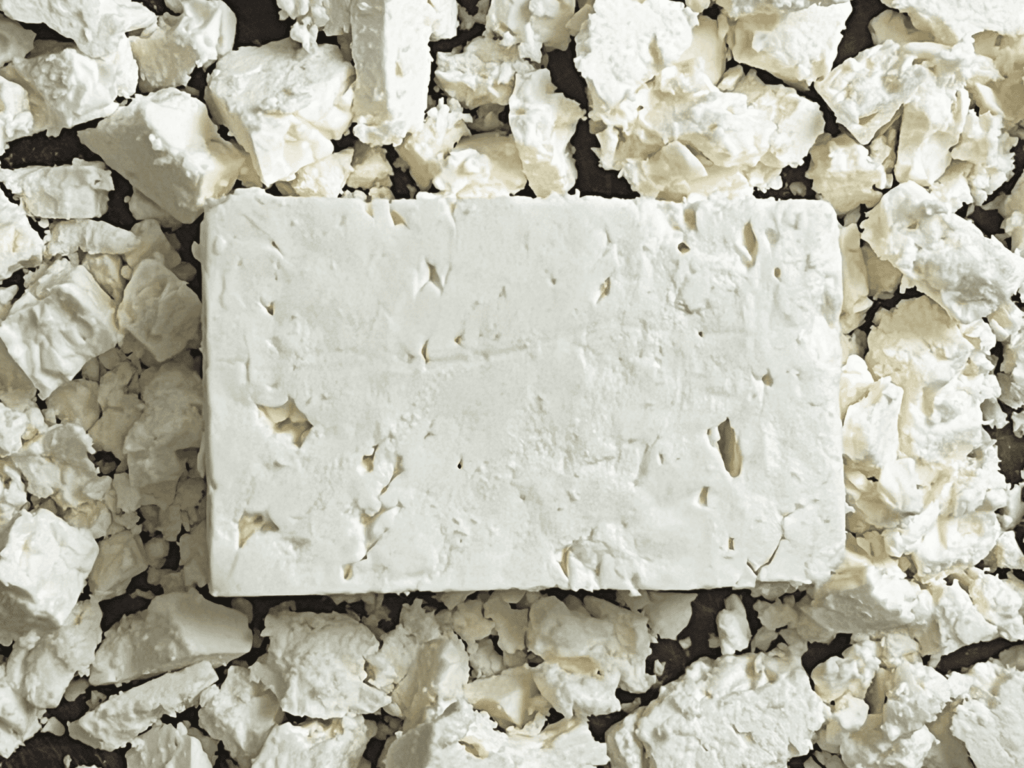
The Greeks have been enjoying feta as a dietary staple for centuries, and the cheese is twirled into their lore and legend. Mythological tales claim the gods sent Apollo’s son Aristaios to teach Greeks the art of cheesemaking. It even garnered a mention in Homer’s epic poem, The Odyssey. “When half of the snow-white milk curdled, he collected it, put it in the woven baskets and kept the other half in a tub to drink.”
In the 1900s, when Greeks set sail to create new communities around the world, other countries, including the US quickly adopted feta onto their tables, and cheesemakers took to learning how to recreate this tangy, salty cheese. Depending on where it is made, feta may include sheep’s, goat’s, or cow’s milk—or a mix— which results in different flavor profiles.
Greek sheep’s milk feta is considered the classic, with a salty flavor and crumbly texture that’s ideal for adding to salads. Check the package for the red and yellow PDO seal that confirms the product is made in Greece and guarantees the animals are fed a local diet. Mild and creamy French feta is generally made from sheep’s or goat’s milk and works best for spreading.
Either way, ensure you purchase feta that is stored in brine, not vacuumed packed. The brine enhances the cheese’s unique flavor, keeps it fresh longer, and makes a wonderful secondary ingredient in a marinade—or even in cocktails.

Feta Blintzes with Strawberries, Lemon, and Honey
The heart of strawberry season arrives in June when the deep red berries are abundant at farmers markets. The ripe sweetness of strawberries paired with salty feta creates a flavor combination that works for breakfast, brunch, or dessert. Craving a blintz off-season? Simply replace strawberries with blackberries, pitted cherries, or blueberries.

Pound Cake with Feta Caramel
This dessert highlights the floral and tangy combination made from pairing lavender with sweet and salty feta caramel. Be sure to use goat’s milk feta as it creates the smoothest and creamiest result. The caramel can also be used to top ice cream or for dipping berries. Food- grade dried lavender can be found at specialty shops and natural food stores.

Aristaeus Martini
Named for the Greek god of cheesemaking and olive growing, the Aristaeus cocktail shakes umami feta brine with vodka and olive oil for depth of flavor. After opening a package of feta, refrigerate brine in a mason jar. Use it to marinate poultry, add to salad dressings, or to “dirty” your favorite martini.

Green Vegetable Shakshuka with Whipped Feta and Cilantro
This one-pan egg and vegetable dish showcases the range of produce available in the spring, from hearty greens to fresh peas. It calls for Shabazi spice, which is based on the classic Yemenite hot sauce and can be used on poultry, fish, and rice; this vibrant green blend is available at large grocery stores and online. Serve the shakshuka family style with crusty bread for dipping.

Grilled Lamb with a Salad of Spring Lettuces, Fresh Herbs, and Creamy Feta Dressing
Lamb is a quintessential spring protein, and pairing it with creamy feta and cooling herbs yields a Mediterranean lunch that is perfect for the first al fresco meal of the season.




